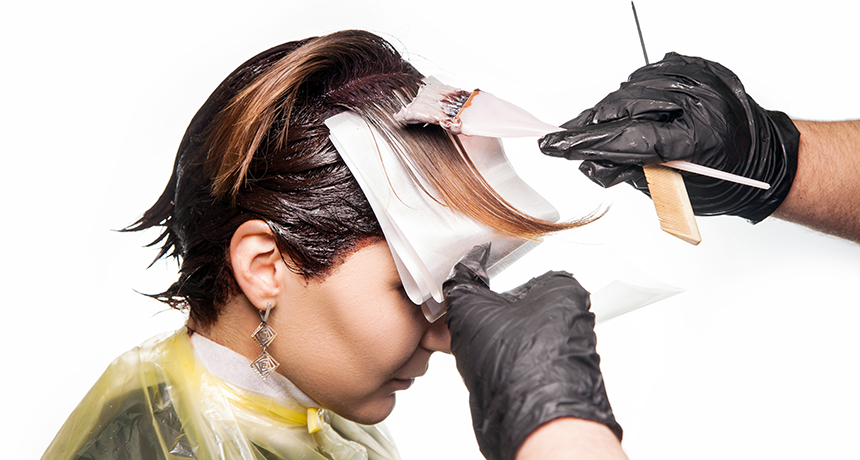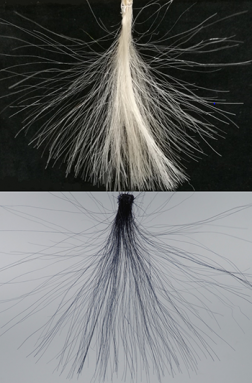New black hair dye uses no harsh chemicals
It lasts as long as store-bought products, but is nontoxic and environmentally friendly

Traditional hair dyes contain lots of nasty, smelly chemicals. Some scientists are working to change all that. Their new graphene-based black dye is nontoxic and as long-lasting as today’s store-bought hair colorings.
Khosrork/istockphoto
“Green” is the new black, at least in hair dyes.
Scientists in Illinois have developed a new environmentally friendly hair dye that delivers stunning black locks. The raven color comes from a form of black carbon — the same basic ingredient as in soot and pencil lead.
Traditional hair dyes are made up of a lot of harsh chemicals. Each performs a certain function. For example, the job of bleach and ammonia is to pry open cellular “scales” on the outside of the hair (the cuticle). This allows the dye’s color to enter the hair strands. A chemical reaction then occurs which produces more color.

But the pungent smell of hair dyes leaves you wondering what type of damage it might do to the scalp and hair. In fact, those chemicals can make hair so fragile that the strands can easily break. Dye ingredients also can dry out the skin. Some scientists worry that hair dyes might even pose more serious risks. Animal studies, for instance, have suggested some ingredients might cause cancer. And some of those chemicals can enter the body as inhaled fumes or by passing through the skin. (To date, however, no studies have confirmed that using these dyes poses health risks to people.)
The new dye uses none of those harsh chemicals, notes Jiaxing Huang. He works at Northwestern University in Evanston, Ill. As a materials scientist, he looks at how to develop new materials based on their physical and chemical properties. He was intrigued by graphene [GRAA-feen]. It’s made from nothing but carbon atoms (and won its initial investigators the 2010 Nobel Prize in physics). This material’s carbon atoms are all locked together into flat sheets, each a single atom thick. And it was the sheet’s thinness that inspired Huang to ponder: What if these black, graphene sheets could wrap around individual strands of hair? Would it change their color?
To find out, he says, “We did a few Friday afternoon experiments in the lab.” And they confirmed “that graphene did, indeed, work quite well at dying hair.” Huang’s team described its test results April 12 in the journal Chem.
Staying power
These black sheets offer an ideal alternative to harsh chemicals for dying hair, Huang suspects. “Graphene sheets are flexible,” he explains. That makes them a good coating to impart an even, black color. Using another version of graphene, known as graphene oxide, the team was able to improve the color palette to include various shades of brown and black.
Graphene also binds well to hair. So this dye will last a long time without fading — through more than 30 washes. That 30-wash durability is a minimum for today’s store-bought hair dyes.
Huang explains why graphene-based hair dyes will last as long, if not longer, than store-bought hair dyes. He likens the color particles in traditional hair dyes to tennis balls. They don’t easily stick. That means that with each shampooing, some can easily roll off of strands of hair, bit by bit. Graphene’s flakes are instead like itsy bitsy wet paper towels. Each can wrap around a hair shaft and really stick.
The new dye should also be safer for hair, skin and overall health, Huang says. Why? It only coats the hair. No cuticles are pried open to insert chemicals. The nontoxic dye doesn’t hurt the skin, and each graphene flake is too big to move through the skin and enter the body.
“Current hair dyes tend to be among the nastier chemical mixtures that people voluntarily put on their bodies,” notes Chris Fellows. He’s a chemist at the University of New England in Armidale, Australia. He, too, thinks the Northwestern formula “seems to be much less toxic” than conventional dyes. Stacks of graphene form graphite, which is the material known as the “lead” in pencils. And, he quips, “We have probably all drawn on ourselves with those at one time or another without any negative consequences.”
Huang would like to see his formula developed into a commercial product. And while dark brown and black are popular hues in hair dyes, he has plans to develop other colors, too.
Graphene also conducts heat and electricity very well. So hair dyed with the graphene-based formula might be used to form part of an electrical circuit. Huang imagines using hair strands as a series of electrodes (electrical conductors). Hair could then be used to measure things. They might work with electronic devices attached to the skin, for instance, to measure such things as heart rate, breathing rate, body temperature or oxygen levels. “This is actually a very fun and potentially useful thing to imagine,” he says. “But I encourage kids to use their free minds and dig deep into their imagination to think of [other] possible uses.”
Fellows let his imagination run wild, too. “Maybe there is a way to use it [graphene] to make an electrochromic [Ee-LEK-troh-KRO-mik] hair dye,” he says. This would allow it to change colors in response to some electrical signal. “Then you could change the color of your hair on the fly. Or make it continuously change in swirling paisley patterns. Or … okay now,” he admits, “I’m just being silly.”







